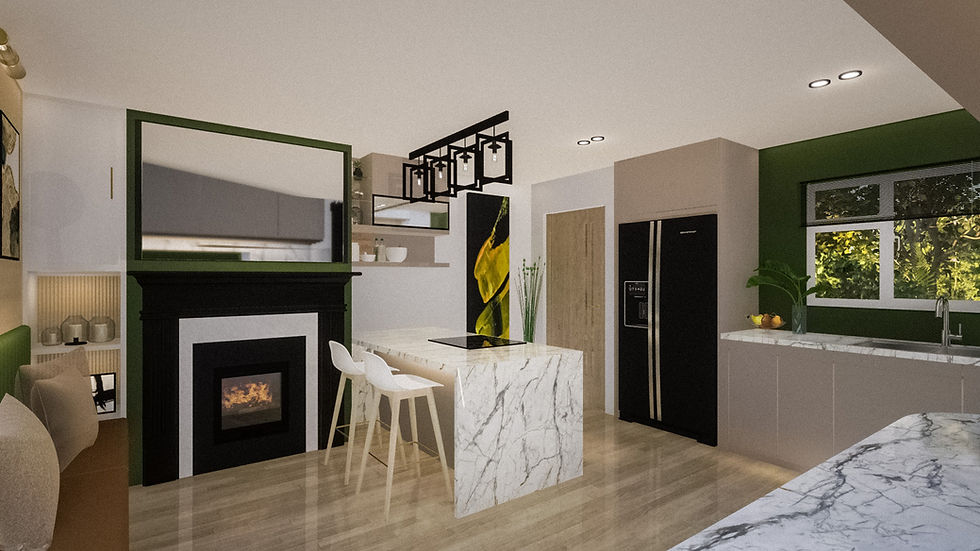Sustainable Interior Design: Eco-Friendly Ideas for Your Home
- KMaria Interiors
- Mar 31
- 4 min read
Updated: Sep 23
In a world where sustainability is more important than ever, creating an eco-friendly home is not only beneficial for the planet but also enhances your living environment. Sustainable interior design focuses on using environmentally responsible materials, reducing waste, and promoting energy efficiency. If you’re looking to make eco-conscious choices in your home, here are some eco-friendly ideas to inspire your next interior design project.

1. Opt for Sustainable Materials
One of the key elements of sustainable interior design is choosing materials that are eco-friendly, renewable, or recycled. When selecting furniture, flooring, or finishes, consider materials that have a low environmental impact.
Reclaimed Wood: Reclaimed or recycled wood is an excellent choice for flooring, furniture, or wall panels. Not only does it add a rustic charm to your space, but it also reduces the demand for new timber and deforestation.
Bamboo: Bamboo is a fast-growing, renewable resource that is perfect for flooring, furniture, and even fabrics. Its strength and durability make it a great alternative to traditional hardwoods.
Cork: Cork is harvested from the bark of cork oak trees, which regrows after each harvest. It’s an excellent insulator, eco-friendly, and provides a soft, natural texture for floors or walls.
Tip: Look for suppliers who source FSC-certified (Forest Stewardship Council) materials to ensure responsible forestry practices.
2. Choose Low-VOC Paints and Finishes
Traditional paints and finishes often contain volatile organic compounds (VOCs) that can release harmful chemicals into your home’s air. When designing an eco-friendly space, opt for low-VOC or zero-VOC paints, stains, and finishes. These products reduce air pollution and create a healthier indoor environment for you and your family.
Tip: Look for brands that prioritise non-toxic ingredients and sustainable packaging to further enhance your green home design.
3. Incorporate Energy-Efficient Lighting
Lighting is a major component of any interior design, and switching to energy-efficient options can make a big difference in reducing your home's carbon footprint. LED bulbs use up to 80% less energy than traditional incandescent bulbs and last much longer, saving both energy and money over time.
Natural Light: Maximise the use of natural light by incorporating large windows, skylights, and reflective surfaces to brighten up your space during the day. This not only reduces energy consumption but also creates a warm, inviting atmosphere.
Smart Lighting: Install smart lighting systems that allow you to control brightness and energy usage with the touch of a button or through a smartphone app, further improving energy efficiency.
Tip: Use dimmable LED lights to control the mood and reduce energy consumption in the evening.
4. Opt for Eco-Friendly Fabrics
When selecting textiles for your home, consider fabrics made from natural, organic, or recycled materials. These not only feel luxurious but also contribute to a more sustainable interior.
Organic Cotton: Unlike conventional cotton, organic cotton is grown without pesticides and harmful chemicals, making it a safer option for both the environment and your home.
Linen: Linen is a durable, eco-friendly fabric made from the flax plant. It requires less water and energy to produce compared to other fabrics, and its timeless, natural aesthetic fits effortlessly into sustainable interior designs.
Hemp: Hemp is another eco-friendly fabric that’s gaining popularity due to its fast-growing nature and low environmental impact. It’s versatile and can be used for curtains, cushions, and upholstery.
Tip: Look for upholstery or fabric suppliers that use sustainable production processes and fair trade practices.
5. Use Recycled and Upcycled Furniture
Buying new furniture can often mean more waste and higher energy consumption, but opting for recycled or upcycled furniture helps reduce this impact. Look for vintage or second-hand pieces that can be repurposed, refinished, or restored to suit your home.
Antique and Vintage: Incorporating vintage furniture into your home adds character and reduces the demand for new resources.
Upcycling: Get creative with upcycling by giving old furniture a new life. A fresh coat of low-VOC paint or new eco-friendly fabric can turn a worn-out piece into a statement item.
Tip: Check out local charity shops, flea markets, or online marketplaces for unique, pre-loved furniture that aligns with your sustainable design goals.
6. Invest in Sustainable Home Décor
Decorating your home sustainably goes beyond furniture and paint. Consider small yet impactful eco-friendly choices in your décor as well.
Eco-Friendly Rugs: Opt for rugs made from natural fibres like jute, wool, or organic cotton. These materials are biodegradable and produced with minimal environmental impact.
Sustainable Art: Support local artists or seek out sustainable artwork made from recycled or repurposed materials. Handcrafted pieces often have lower carbon footprints and add a personal touch to your space.
Houseplants: Adding greenery to your home not only enhances your décor but also purifies the air and brings a natural, calming vibe. Choose low-maintenance plants like spider plants, succulents, or ferns to enhance your space sustainably.
Tip: Choose home accessories made from recycled materials or ethically sourced natural products to align with your sustainable values.
7. Work with Sustainable Interior Designers and Suppliers
When embarking on a sustainable interior design project, it’s crucial to work with professionals and suppliers who share your eco-friendly vision. Many interior designers specialise in sustainable design and can help you source materials and furniture that meet environmental standards.
Tip: Ask suppliers for information on the origins of their materials and their sustainability practices to ensure you’re making eco-conscious choices.
Sustainable interior design is all about making thoughtful, eco-friendly choices that enhance your home's beauty while reducing environmental impact. By incorporating renewable materials, energy-efficient lighting, and sustainable textiles, you can create a stylish and responsible living space that benefits both you and the planet.




Comments